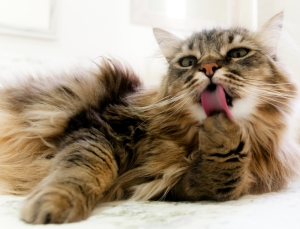I don’t know about you, but nothing gets me out of bed faster than hearing my cat trying to vomit up a hairball.
And if your cats are anything like mine, they tend to vomit up the hairball in the most inconvenient places: my shoes, a favorite book, the newly shampooed carpet, the kitchen counter, etc.
Studies have shown that 50 percent to 80 percent of cats routinely vomit up a hairball at least once a month.
How do hairballs form?
A hairball, or trichobezoar, develops from hair that your cat ingests during grooming.
While most of the swallowed hair passes through the cat’s intestinal tract, occasionally it accumulates into a large clump within the stomach. Once a hairball forms, it becomes irritating to the stomach, causing your cat to vomit.
A hairball is typically cylindrical shaped, like a cigar or sausage. It is usually the color of the cat’s fur, darkened by the color of food and gastric secretions, like green-colored bile. (Lovely!) The ejected matter will typically have an unpleasant, but tolerable odor.
Long-haired cats, like Persians and Maine Coons, may be at greater risk for developing hairballs.
Cats tend to form hairballs more frequently during certain seasons of the year when they normally shed their coats.
Can they be prevented?
The good news is that the majority of hairballs, while unpleasant and inconvenient, are not life-threatening. You can decrease the frequency of hairball formation in your cat by brushing your cat daily, using a hairball control diet, or using one of the commercial hairball remedies that can be purchased from your veterinarian or pet store.
When to see a veterinarian
Occasionally a large hairball may pass through the stomach and become lodged in the small intestine, creating an obstruction or blockage. This can become a life-threatening condition if not treated appropriately.
You should schedule an appointment with your veterinarian ASAP if your cat:
- stops eating,
- vomits several times a day for more than one day,
- attempts to vomit but is not able to produce anything, or
- appears to be constipated.
A cat that vomits a hairball more than once or twice a month could have an underlying disease process such as inflammatory bowel disease, pancreatitis, skin allergies, food allergies or even cancer. A trip to the veterinarian is in order if you are cleaning up hairballs more than twice a month.
Happy Hairball Awareness Day, everyone! Treat your kitty to a little extra TLC and hair-brushing today.

